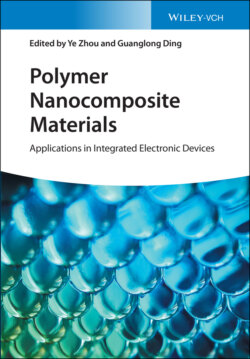Читать книгу Polymer Nanocomposite Materials - Группа авторов - Страница 36
2.3.1 Random Dispersion of Nanofiller in the Polymer Matrix
ОглавлениеThe most straightforward and popular strategy to fabricate CPCs is the incorporation of conductive fillers (e.g. graphene, CNTs) in the polymer matrix by either melting or solution method. Naturally, the nanofillers are randomly located in the polymer matrix, and some of them may be squeezed out to polymer surface in particular at a high filler concentration [76]. The nanofillers can be uniformly distributed in the fibers, film, and three-dimensional polymer materials, depending on the processing technology used. Wet-spinning [77, 78] and electrospinning [75, 79] are two most common means to prepare one dimensional CPCs. Yu et al. [80] have successfully prepared conductive poly(styrenebutadiene-styrene) (SBS)/CNT fiber through wet-spinning the mixed solution of CNT and SBS elastomer. The schematic diagram of the fabrication procedure of SBS/CNT and the pictures of flexible SBS composite with different content of CNTs are shown in Figure 2.3a. Figure 2.3b–d show the SEM micrographs of fracture SBS/CNT fibers with a content of 0.5%, 0.75%, and 1%, respectively. Uniformly dispersed CNTs in SBS matrix can be observed even at a CNT content of 1%. Also, the conductivity of the obtained 1-D conductive fiber composite improves with the increase of CNT content (Figure 2.3e).
Figure 2.3 (a) Schematic diagram illustrating the preparation procedure for SBS/CNT fibers (SCFs) and photograph of SCFs with the various content of CNT. (b–d) The cross-sectional morphologies of SBS/CNT fibers containing different content of CNT. (e) The specific conductivities of SFCs as a function of different loading content of CNT. Source: (a)–(e) Reproduced with permission. [80] Copyright 2018, Elsevier Ltd. (f) Schematic illustration of the PU-PEDOT:PSS/SWCNT/PU-PEDOT:PSS with sandwiched structure on a polydimethylsiloxane (PDMS) substrate. (g) Transmittance of the integrated composite in the visible wavelength range from 350 to 700 nm. Source: (f)–(g) Reproduced with permission. [81] Copyright 2015, American Chemical Society.
Thin film-like CPCs can be fabricated by facile casting or template molding [82, 83] or polymer encapsulation [81, 84–86]. A stretchable, transparent, patchable nanohybrid conductive polymer film was reported by Roh et al. [81]. The CNTs were encapsulated in the interlayer of polyurethane (PU)-poly(3,4-ethylenedioxythiophene) polystyrenesulfonate (PEDOT:PSS) forming a sandwich-like structure, which is schematically illustrated in Figure 2.3f, where the CNTs functioned like a bridge that connects the conductive PEDOT to the PEDOT phases. The obtained sandwich-like composite with 5 mg ml−1 SWCNT dispersion is optical transparent and shows the optical transmittance of 62% in the visible range (Figure 2.3g).
In terms of three-dimensional composite, nanofillers are often distributed in a foam composite that is usually obtained by freezing drying method [87, 88]. For example, Huang et al. [87] fabricated a novel aligned porous CNT/thermoplastic polyurethane (TPU) foam composite by using a directional-freezing method. During the freezing–drying process, the solvent of the mixture would form directional crystal due to the low temperature and then the ice crystal of the solvent would be sublimated, leaving aligned interconnected pores.
